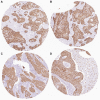Keratin 6A (KRT6A) promotes radioresistance, invasion, and metastasis in lung cancer via p53 signaling pathway
- PMID: 38656878
- PMCID: PMC11087103
- DOI: 10.18632/aging.205742
Keratin 6A (KRT6A) promotes radioresistance, invasion, and metastasis in lung cancer via p53 signaling pathway
Abstract
Background: It is reported that the incidence rate and mortality of lung cancer are very high. Therefore, early diagnosis and identification of specific biomarkers are crucial for the clinical treatment of lung cancer. This study aims to comprehensively investigate the prognostic significance of KRT6A in human lung cancer.
Methods: The GEO2R online tool was utilized to analyze the differential expression of mRNA between lung carcinoma tissues and radioresistant tissues in the GSE73095 and GSE197236 datasets. DAVID database was used to perform GO and KEGG enrichment analyses on target genes. The Kaplan-Meier plotter tool was used to analyze the impact of key messenger ribonucleic acid on the survival status of lung cancer. In addition, quantitative real-time polymerase chain reaction (qPCR) was used to investigate the impact of key genes on the phenotype of lung cancer cells. After the knockout, we conducted cell migration and CCK-8 experiments to detect their effects on cell proliferation and invasion.
Results: 40 differentially expressed genes (DEGs) were chosen from GSE73095 and 118 DEGs were chosen from GSE197236. Kaplan-Meier map analysis showed that the overall cancer survival rate of the high-expression KRT6A group was higher than that of the low-expression group (P < 0.05). Besides, cell experiments have shown that when the KRT6A gene is downregulated, the proliferation and invasion ability of lung cancer cells is weakened.
Conclusions: Our research concluded that KRT6A may take part in the radioresistance and progression of lung cancer and can be a potential biomarker for lung cancer patients.
Keywords: CCK-8; GEO; KRT6A; lung cancer; radioresistance.
Conflict of interest statement
Figures






References
Publication types
MeSH terms
Substances
LinkOut - more resources
Full Text Sources
Medical
Research Materials
Miscellaneous

